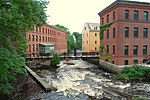Boston College High School
1863 establishments in MassachusettsAll pages needing cleanupBoys' schools in MassachusettsCatholic Conference (MIAA)Catholic secondary schools in Massachusetts ... and 4 more
Educational institutions established in 1863High schools in BostonJesuit high schools in the United StatesSexual abuse scandal in the Society of Jesus
Boston College High School (also known as BC High) is an all-male, Jesuit, Catholic college preparatory high school for grades 7–12 in Boston, Massachusetts. It is located on Columbia Point in Dorchester.
Excerpt from the Wikipedia article Boston College High School (License: CC BY-SA 3.0, Authors).Boston College High School
William T. Morrissey Boulevard, Boston Dorchester
Geographical coordinates (GPS) Address Nearby Places Show on map
Geographical coordinates (GPS)
| Latitude | Longitude |
|---|---|
| N 42.316111111111 ° | E -71.046388888889 ° |
Address
William T. Morrissey Boulevard 150
02125 Boston, Dorchester
Massachusetts, United States
Open on Google Maps







